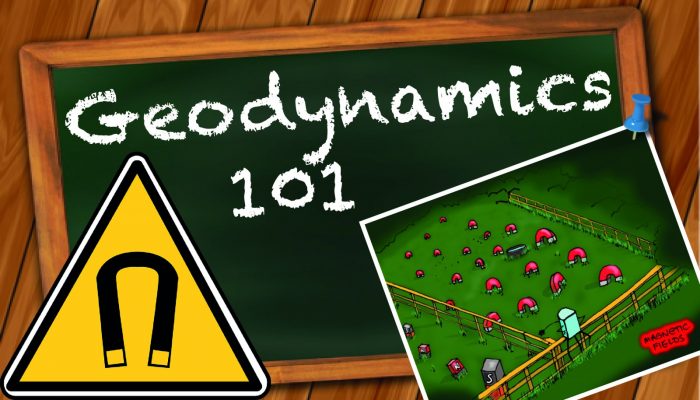
The Geodynamics 101 series serves to show the diversity of topics and methods in the geodynamics community in an understandable manner for every geodynamicist. PhD’s, postdocs, full professors, and everyone in between can introduce their field of expertise in a lighthearted, entertaining manner and touch on some of the outstanding questions and problems related to their method of choice.
This week Maurits Metman, PhD student at the Deep Earth Research group at the University of Leeds in the United Kingdom, explains the dynamics of the core. Do you want to talk about your research area? Contact us!
 Rock bottom
Rock bottom
Approximately 3,000 km below our relatively minuscule feet lies the Earth’s core. It is our planet’s innermost and therefore most secluded region. It is also the primary source of Earth’s magnetic field that we observe here at the surface. With its dynamics, composition, magnetic field generation, and thermal history not yet completely understood, the core remains amongst the most enigmatic parts of the Earth. It has been established that the core can be partitioned in an inner and outer region, which have distinct physical and chemical properties. For example, the two regions are in a different state of matter: the inner core being solid and the outer core liquid. Therefore, it is the outer core that is of particular geodynamical interest – here we will touch upon some important aspects of the dynamics that take place within the outer core.
The outer core consists of an electrically conducting iron alloy liquid, which circulates throughout the outer core volume. In terms of the forces that drive these motions, there are similarities to the dynamics of other terrestrial systems such as the mantle, oceans, and atmosphere. For example, in all cases gravitational forces are overcome by the process of convection, through which relatively hot and buoyant material at the base of the system rises towards the surface, while elsewhere cold material sinks. Additionally, the flows in these systems are subject to forces due to pressure differences and those associated with the deformation of the material.
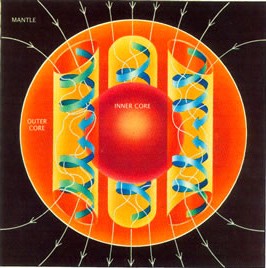
Figure 1: An impression of convection in the outer core (not to scale), which is aligned along columnar rolls, and flow in- and outside the tangent cylinder is separated (Credit: United States Geological Survey).
Nevertheless, the dynamics in the outer core are certainly different to other geophysical flows. For one, it is estimated that a typical velocity for outer core flow U ∼ 10-1 mm s-1, which is relatively high for the solid Earth. In fact, recent work has shown that these velocities may locally be as high as roughly 1 mm s-1 (Livermore et al., 2016). Additionally, rotational effects (e.g. centrifugal force, Coriolis effect) have a tremendous impact on the style of convection. This is for example not the case in the mantle, due to the fact that flow velocity is comparatively low there and viscosity is large. In this respect, the so-called Taylor-Proudman theorem provides an important constraint on the style of core motions, and states that for rapidly rotating systems flow is two-dimensional: it can not change parallel to the axis of rotation. More generally, the style of convection inside of the outer core is strongly cylindrical, in the sense that flow is aligned in ‘columnar rolls’ aligned with the axis of rotation (Fig. 1).
Magnetic soup
With its ability to generate a magnetic field, the outer core further distinguishes itself from other parts of the Earth. That this field must indeed be generated somewhere inside the Earth was already demonstrated by Gilbert (1600), but the fact that it is linked to core fluid flow remained unknown for centuries. We now know that the convective motion of the electrically conducting outer core liquid generates such a magnetic field. This conversion of kinetic to magnetic energy is a process that has fittingly been coined the geodynamo.
What clues do we have that this field must be generated internally? A relatively simple argument can be made from the age of the magnetic field, which paleomagnetic observations have shown to be over 109 year. However, if we were to assume there would be no field generation, the present-day field would decay through simple diffusion (or equivalently due to Joule heating of the fluid) on a timescale of 105 year, inconsistent with these observations. Therefore, it is required that some field generation in the outer core acts to sustain the magnetic field against diffusion, which can be accomplished with a specific core fluid flow there.
Initially, some rejected the existence of such a flow. One well known so-called anti-dynamo theorem is Cowling’s (1933), who showed that a steady and axisymmetric flow field can never maintain a magnetic field indefinitely, which led to the general consensus that sustained dynamo action through fluid flow would not be possible.
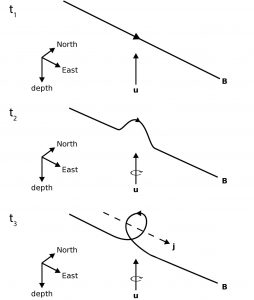
Figure 2: A schematic of magnetic field generation through the α-effect at different timesteps ti. Here, u, B and j represent fluid velocity, magnetic field and electric current density.
The development of the mean-field theory, which describes how small-scale flow perturbations can on average create a large-scale magnetic field, changed this. An example of such field generation is through the α-effect (Parker, 1955). In this case there is a rising and rotating flow (imagine a corkscrew-shaped motion) moving and twisting a magnetic field line (Fig. 2). The magnetic loops created this way induce an electric current parallel to the the field, which in turn generate a secondary magnetic field that is perpendicular to the initial field. A similar conversion the other way around is also possible, and a planetary dynamo that relies on these two processes is considered to be of the α2-type. Another source of field generation that follows from mean field theory is the ω-effect. This process is the bending of magnetic field lines, due to the differences in rotation rate, also creating magnetic field in a direction opposite to the initial direction (Fig. 3). A dynamo that generates a magnetic field through the α- and ω-effect is referred to as an αω-dynamo.
Therefore, it is quite clear that core flow and Earth’s internal magnetic field are deeply intertwined. As mentioned earlier, field generation through fluid motion and field diffusion are two competing processes that control time variations in the field. The magnetic Reynolds number is the ratio of the magnitudes of these contributions, and is defined as:
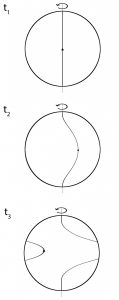
Figure 3: A schematic of the ω-effect which converts the magnetic field from the initial direction (aligned South-North) to a secondary direction (West-East and vice versa), at different timesteps ti. The solid and dashed curve represent the magnetic field and rotation axis, respectively.
Rm = UL / η
where η is the magnetic diffusivity and L is a length scale for the magnetic field (Roberts and Scott, 1965). For the outer core it is estimated that Rm ∼ 102, and therefore the diffusion term is often considered negligible (at least for relatively large length scales). This is referred to as the frozen-flux approximation. As the name suggests, magnetic field lines are then dynamically ‘frozen’ into the liquid, so that they evolve as though they were material line elements. How realistic is this particular scenario? From the above equation it should be clear that the frozen-flux approximation can break down if the typical length scale decreases. This may for example be the case for flux expulsion, i.e. when a radially expelled field is concentrated below the core-mantle boundary (Bloxham, 1986). This concentration increases the gradient of the field locally, enhancing radial diffusion. However, to what extent this process is realistic remains a subject for debate.
Forecast: reversals?
For the last two decades, advances in computing power have allowed numerical models to reproduce certain properties of the Earth’s magnetic field. For example, such models have been shown to exhibit magnetic polarity reversals (Glatzmaier & Roberts, 1995) and Rm that are similar to the outer core’s. Despite this numerical success and despite the fact that reversals have been documented extensively within the field of paleomagnetism, it remains unknown what physical process underlies these phenomena. This is particularly interesting as the most recent reversal occurred around 0.78 Myr years ago, which has led to speculation that a future reversal is imminent. Future numerical work, increases in computing power, better theoretical understanding of the internal dynamics of the core, and more geomagnetic observations may in time provide a physical explanation for these events.
References Bloxham, J. (1986). The expulsion of magnetic flux from the Earth’s core. Geophysical Journal International, 87(2):669-678. Cowling T. G. (1933) The magnetic field of sunspots. Monthly Notices of the Royal Astronomical Society 94: 39-48. Gilbert W. (1600) De Magnete. London: P. Short. Glatzmaier G. and Roberts P. (1995) A three-dimensional self-consistent computer simulation of a geomagnetic field reversal. Nature 337: 203-209. Livermore, P. W., Hollerbach, R. and Finlay C. C. (2016). An accelerating high-latitude jet in Earth's core. Nature Geoscience 10: 62-68. Parker E. N. (1955) Hydrodynamic dynamo models. Astrophysical Journal 122: 293-314. Roberts, P. H. and Scott, S. (1965). On Analysis of the Secular Variation. 1. A Hydromagnetic Constraint: Theory. Journal of Geomagnetism and Geoelectricity, 17(2):137-151.


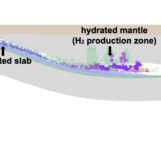
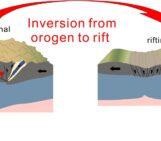

Ufas Webmaster
Nice article. Thank you very much